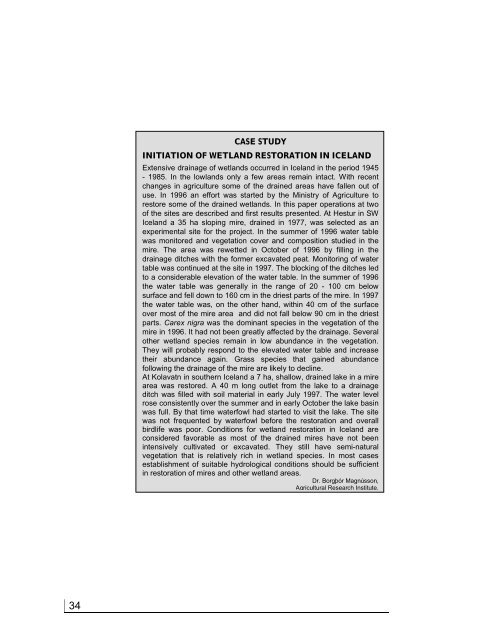BIOLOGICAL DIVERSITY IN ICELAND - Convention on Biological ...
BIOLOGICAL DIVERSITY IN ICELAND - Convention on Biological ...
BIOLOGICAL DIVERSITY IN ICELAND - Convention on Biological ...
- No tags were found...
Create successful ePaper yourself
Turn your PDF publications into a flip-book with our unique Google optimized e-Paper software.
CASE STUDY<str<strong>on</strong>g>IN</str<strong>on</strong>g>ITIATION OF WETLAND RESTORATION <str<strong>on</strong>g>IN</str<strong>on</strong>g> <str<strong>on</strong>g>ICELAND</str<strong>on</strong>g>Extensive drainage of wetlands occurred in Iceland in the period 1945- 1985. In the lowlands <strong>on</strong>ly a few areas remain intact. With recentchanges in agriculture some of the drained areas have fallen out ofuse. In 1996 an effort was started by the Ministry of Agriculture torestore some of the drained wetlands. In this paper operati<strong>on</strong>s at twoof the sites are described and first results presented. At Hestur in SWIceland a 35 ha sloping mire, drained in 1977, was selected as anexperimental site for the project. In the summer of 1996 water tablewas m<strong>on</strong>itored and vegetati<strong>on</strong> cover and compositi<strong>on</strong> studied in themire. The area was rewetted in October of 1996 by filling in thedrainage ditches with the former excavated peat. M<strong>on</strong>itoring of watertable was c<strong>on</strong>tinued at the site in 1997. The blocking of the ditches ledto a c<strong>on</strong>siderable elevati<strong>on</strong> of the water table. In the summer of 1996the water table was generally in the range of 20 - 100 cm belowsurface and fell down to 160 cm in the driest parts of the mire. In 1997the water table was, <strong>on</strong> the other hand, within 40 cm of the surfaceover most of the mire area and did not fall below 90 cm in the driestparts. Carex nigra was the dominant species in the vegetati<strong>on</strong> of themire in 1996. It had not been greatly affected by the drainage. Severalother wetland species remain in low abundance in the vegetati<strong>on</strong>.They will probably resp<strong>on</strong>d to the elevated water table and increasetheir abundance again. Grass species that gained abundancefollowing the drainage of the mire are likely to decline.At Kolavatn in southern Iceland a 7 ha, shallow, drained lake in a mirearea was restored. A 40 m l<strong>on</strong>g outlet from the lake to a drainageditch was filled with soil material in early July 1997. The water levelrose c<strong>on</strong>sistently over the summer and in early October the lake basinwas full. By that time waterfowl had started to visit the lake. The sitewas not frequented by waterfowl before the restorati<strong>on</strong> and overallbirdlife was poor. C<strong>on</strong>diti<strong>on</strong>s for wetland restorati<strong>on</strong> in Iceland arec<strong>on</strong>sidered favorable as most of the drained mires have not beenintensively cultivated or excavated. They still have semi-naturalvegetati<strong>on</strong> that is relatively rich in wetland species. In most casesestablishment of suitable hydrological c<strong>on</strong>diti<strong>on</strong>s should be sufficientin restorati<strong>on</strong> of mires and other wetland areas.Dr. Borgþór Magnúss<strong>on</strong>,Agricultural Research Institute.34
















